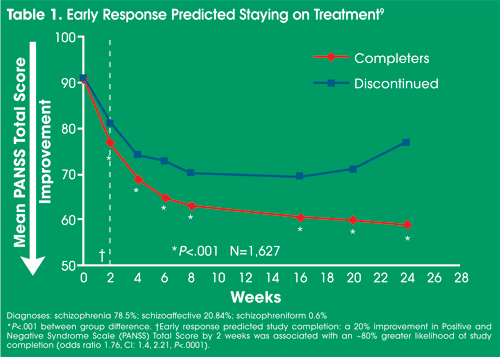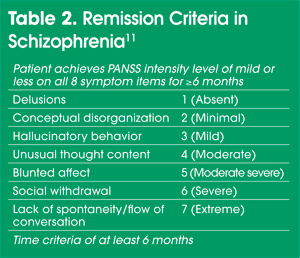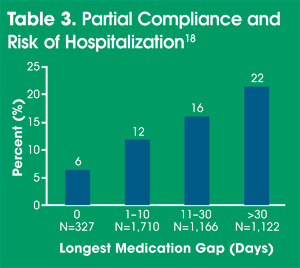Print Friendly
Practical Dosing Strategies in the Treatment of Schizophrenia: Part 3 - Maintenance Strategies in Schizophrenia

John M. Kane, MD
Chairman, Department of Psychiatry, The Zucker Hillside Hospital; Professor of Psychiatry, Neurology and Neuroscience, The Albert Einstein College of Medicine
CME Course Director
James C.-Y. Chou, MD
Associate Professor of Psychiatry at Mount Sinai School of Medicine

Accreditation Statement
This activity has been planned and implemented in accordance with the Essential Areas and policies of the Accreditation Council for Continuing Medical Education (ACCME) through the joint sponsorship of the Mount Sinai School of Medicine and MBL Communications, Inc. The Mount Sinai School of Medicine is accredited by the ACCME to provide continuing medical education for physicians.
Credit Designation
The Mount Sinai School of Medicine designates this educational activity for a maximum of 1 AMA PRA Category 1 Credit™. Physicians should only claim credit commensurate with the extent of their participation in the activity.
Faculty Disclosure Policy Statement
It is the policy of the Mount Sinai School of Medicine to ensure objectivity, balance, independence, transparency, and scientific rigor in all CME-sponsored educational activities. All faculty participating in the planning or implementation of a sponsored activity are expected to disclose to the audience any relevant financial relationships and to assist in resolving any conflict of interest that may arise from the relationship. Presenters must also make a meaningful disclosure to the audience of their discussions of unlabeled or unapproved drugs or devices.
Statement of Need
In preparing patients with schizophrenia for maintenance treatment, it is important to consider, among other questions, the minimum levels of acceptable improvement. Adherence must be assessed and blood levels should be done (if feasible) to ensure that patients have an adequate amount of medication in their system. It is strongly recommended that treatment decisions in schizophrenia be measurement-based so that the clinicians are using quantitative assessment to help guide their decision-making process. Quantitative measurements can be helpful in establishing baseline severity, providing targets for treatment goals, and evaluating the progress made in achieving those goals.
Medication non-adherence is one of the major reasons for the significant rates of relapse and re-hospitalization in schizophrenia. A medication gap as short as 10 days can double the risk of re-hospitalization for schizophrenia, and there is a steady—nearly linear—increase of risk as the gap widens. New information technology might be brought to bear in helping to reduce non-adherence. Also, that the use of long-acting injectable medication can be of enormous value in helping patients to ensure that they are getting the full benefits of the medication. Finally, clinicians must provide the framework for open discussion with patients regarding key areas in which the patient’s perception of their own treatment can affect adherence.
Target Audience
This activity will benefit psychiatrists, hospital staff physicians, and office-based “attending” physicians from the community.
Learning Objectives
• Integrate the use of quantitative measurements into the practice of schizophrenia treatment
• Discuss the timeframe associated with the onset of action for antipsychotics
• Explain the most well-documented triggers, and their risks, for recurrence of a psychotic episode
Faculty Disclosure
John M. Kane, MD, has, within the past one year, served as a consultant to/received speaking honoraria from AstraZeneca, Bristol-Myers Squibb, Eli Lilly, Janssen, and Novartis; has served on the advisory board of AstraZeneca, Bristol-Myers Squibb, Eli Lilly, Janssen, and Novartis; and received honoraria from Eli Lilly and Janssen.
James C.-Y. Chou, MD, has, within the past one year, received honoraria from AstraZeneca, Bristol-Myers Squibb, Eli Lilly, GlaxoSmithKline, Janssen, Merck, Novartis, and Pfizer.
Eran Chemerinski, MD, Assistant Professor of Psychiatry at Mount Sinai School of Medicine, reports no affiliations with, or financial interests in, any organization that may pose a conflict of interest.
Activity Review Information
The activity content has been peer-reviewed by Eran Chemerinski, MD. Review Date: March 22, 2010.
Acknowledgment of Commercial Support
Funding for this activity has been provided by an educational grant from Pfizer Inc.
To Receive Credit for this Activity
Read this poster, reflect on the information presented, and then complete the CME posttest found in the accompanying brochure or online (mbl.cmeoutreach.com). To obtain credit you should score 70% or better. The estimated time to complete this activity is 1 hour.
Release Date: May 3, 2010
Termination Date: May 3, 2012
Introduction
A key consideration in the discussion of maintenance treatment in schizophrenia is how to first help bring patients to the point where acute psychopathology is sufficiently controlled, so that we can focus on consolidating the gains achieved and prevent a recurrence of illness.
The different phases of treatment and response in schizophrenia include the acute phase, wherein we look for response and resolution; remission, where we control symptoms to levels of mild or less and work toward preventing relapse or any exacerbation of psychopathology; and recovery, meaning the ability to function in the community in the workplace, school, family roles, etc.
In preparing patients with schizophrenia for maintenance treatment, clinicians must ensure that they have done everything possible to alleviate the acute signs and symptoms of the illness to the extent possible.
There are several questions to consider at this stage: How much improvement is enough? When do we change treatments, and why? What about adverse effects and the locus of care? In the context of this process of deciding how to bring about the best possible treatment response, we must consider that, if a patient is not responding, the diagnosis may need to be reevaluated. Adherence must be assessed and blood levels should be done (if feasible) to ensure that patients have an adequate amount of medication in their system. If blood levels are unavailable and adherence is an issue, the use of long-acting injectable medication should be considered. The clinician might decide to alter the medication dose—to increase it, or perhaps decrease it if significant side effects are impeding therapeutic response. Adjunct medications or a switching strategy may be employed. Non-pharmacologic therapy, such as cognitive behavioral therapy, which can be effective at reducing symptoms of schizophrenia, should also be considered.1
The Value of Measurement
It is strongly recommended that treatment decisions in schizophrenia be measurement-based so that the clinicians are using quantitative assessment to help guide their decision-making process. Quantitative measurements can be helpful in establishing baseline severity, providing targets for treatment goals, and evaluating the progress made in achieving those goals.2,3 Examples of quantifiable psychopathology from the Brief Psychiatric Rating Scale include depression, guilt, hostility, elevated mood, disorientation, and self-neglect.4 Quantitative assessment of tolerability and adverse events should also be conducted.
Unfortunately, a lot of clinicians do not use measurements efficiently. Some clinicians may feel that their overall clinical impression is sufficient, or that quantitative assessments are prohibited by time constraints, or there may be reimbursement concerns, wherein an insurance company may use the quantitative measurements to question the locus of care, or another aspect of the treatment. None of these obstacles should ultimately get in the way of quantitative assessment.
Onset of Medication Response
The actual onset of antipsychotic drug response is another area of concern for clinicians. For example, does early response predict later response, and should early response be used as a guide on whether to continue the current treatment? The observation that response to medication can occur early has been confirmed and extended,5,6 but there is always the possibility of no substantial response, regardless of time on medication.
A survey of 47 schizophrenia experts around the United States7 posed an extensive series of questions, including “what is the average minimum and maximum number of weeks [to] wait before making a major change in treatment regimen in a patient with a psychotic disorder?” Clinician responses varied anywhere from a minimum of ~3 weeks to a maximum of ~6 weeks, a broad range, suggesting that there is no clear-cut demarcation of when one might consider a trial unsuccessful. This is also important because the current average duration of hospitalization for someone with schizophrenia is probably <6 weeks and may in fact be <3 weeks.
Evidence suggests that evaluating response after 2 weeks may be a valuable predictor of how patients will ultimately respond.8 This study’s response criterion was 20% improvement on the total Positive and Negative Syndrome Score (PANSS) at 2 weeks. There was a dramatic difference in response at 24 weeks between patients with ≥20% improvement and patients with <20% improvement at 2 weeks. The disparity in response was still fairly dramatic even after 24 weeks, suggesting that the early non-responders never catch up to the early responders.8 This may provide some valuable predictive information and has implications for how we prepare patients for maintenance treatment. That is, should we consider a change in treatment during early phase treatment for early non-responders in attempt to achieve a greater likelihood of remission at ~24 weeks?
A post-hoc, pooled analysis of four different clinical trials lasting 24–28 weeks, with >1,600 patients, suggested that patients who experience a 20% improvement after 2 weeks are actually more likely to complete the trial (Table 1).5,9 This suggests that if patients can notice some improvement in the first 2 weeks they are more likely to continue on that treatment. These findings clearly hold implications for adherence, as well. In addition, patients categorized as early responders did better in terms of subjective well-being, quality of life and cost of care.10
Click to Enlarge

Remission Criteria
Once the best-possible level of response is achieved, the clinical focus shifts onto maintaining that response and trying to prevent relapse.
We developed a set of criteria defining remission (Table 2). These criteria require that patients have no more than mild levels of several major symptoms associated with the diagnosis of schizophrenia.11 They also represent the treatment standard, in terms of acute treatment (ie, we want patients to achieve remission), and what we are trying to sustain in maintenance treatment. Patients must meet these criteria for a minimum of 6 months to be considered remitted, ie, no rating greater than mild on any of these 8 items for 6 continuous months.
Click to Enlarge

FGAs v SGAs
First-generation antipsychotics (FGAs) have been compared to second-generation antipsychotics (SGAs) with relapse as the outcome measure.12 All the trials included in this review lasted one year and compared an FGA and an SGA. The meta-analysis showed that the relapse rate of the SGAs is significantly lower than the relapse rate of the FGAs, showing a reduction in the relapse rate from 23% on the FGAs, to 15% on the SGAs. The number needed to treat was 13, putting these findings into perspective. An alternative interpretation of these results is that there was a relative risk reduction of 35%, which is quite substantial. Some individual trials in this meta-analysis did not show a significant difference, however, underscoring the potential value of combining data from multiple studies to garner a more meaningful perspective. Among first episode patients there do not appear to be major differences in relapse rates among patients taking second-generation medications.13 The potential for differential rates of recovery between medications has not been adequately studied in controlled, long-term trials.
Treatment Adherence
In maintenance treatment, clinicians and patients sometimes consider discontinuing medications completely with the understanding that the patient, clinician, and social/familial support system will help monitor their symptoms. Theoretically, if any early signs of worsening or relapse emerge, the patient will immediately restart medication and hopefully prevent relapse. This notion has been tested by a number of large, very carefully conducted studies demonstrating that patients who had their medications interrupted were significantly more likely to relapse than those who stayed on continuous treatment.14,15 With such a considerable risk of relapse, we would argue that there is rarely any justification for discontinuance of treatment during the maintenance phase. (Although there is no universally accepted definition of relapse, most investigators use a significant increase in psychopathology, aggressiveness or suicidality and/or an increase in the dosage of medication or level of supervision required.)
One of the major reasons for the significant rates16 of relapse and re-hospitalization is medication non-adherence.17,18 Other reasons include psychosocial stressors and substance abuse, but some patients relapse for reasons we do not understand. Adherence is poor across physical and psychiatric disorders, and particularly in persistent disorders, where treatments are designed to prevent symptom onset or recurrence, and the consequences of stopping treatment are delayed.19,20 A medication gap as short as 10 days can double the risk of re-hospitalization for schizophrenia, and there is a steady—nearly linear—increase of risk as the gap widens (Table 3).18,20
Click to Enlarge

Non-adherence is a very serious problem in schizophrenia, with ~75% of patients having some degree of non-adherence within two years of hospital discharge.17,19-22 Non-adherence has also been associated with an increase in the risk of suicide. Dutch investigators demonstrated that a medication interruption of ≥30 days led to a very substantial increase in the risk of suicide attempts (adjusted relative risk, 4.2; 95% CI 1.7-10.1) compared to patients who continued to take their medication without interruption.23
A pharmacy records analysis comparing the fill rates of older and newer antipsychotics suggests that there is some potential adherence advantage with the newer medications.24 Newer medications, however, have certainly not solved the problem of medication non-adherence. We as clinicians must continue to struggle with this issue and seek better solutions.
Researchers asked schizophrenia experts to state what percentage of patients in clinical trials have been found to be fully adherent, based on their individual knowledge of the literature. The experts’ average reply was that 28% of all schizophrenia patients adhere to treatment. When asked what proportion of their own patients were fully adherent, the same sample of experts reported that 43% of their patients adhere to treatment.7 This interesting illustration suggests that we as clinicians tend to believe that our patients are more adherent than other clinicians’ patients. That is unlikely to be the case, according to the literature, and such an idea may lull individual clinicians into a false sense of security about their patients’ adherence.
New information technology (IT) might be brought to bear in helping to reduce non-adherence. A pilot study tested home teleconferencing and PC-to-mobile text messaging monitoring in 45 patients with psychotic illness.25 Patients and families reported early warning signs in this study, as well. There was a 60% decrease in the number of hospitalizations in the IT group. Patient participation in monitoring efforts, and the involvement of a family member, were associated with lower numbers of relapse and lower rates of re-hospitalization.
We also believe that the use of long-acting injectable medication can be of enormous value in helping patients to ensure that they are getting the full benefits of the medication.
Patients’ Perception of Treatment
The Medication Interest Model is one approach to discussing treatment with patients, providing a framework for working with patients to help them achieve better rates of adherence: 1) Efficacy: we want the patients to appreciate that the drug does make them feel better and is helping them to achieve their own goals; 2) Cost: it is worth it for patients to take the drug; 3) Stigma: the meaning of taking the drug—“What does it say about me that I have to take this drug?” These are three domains that must be addressed with the patient to ensure that he or she has sufficient interest in actually taking the medication.26
Case Report
CV is a 24-year-old single male currently living with his family. He is employed part-time by a messenger service.
He has had two prior hospitalizations, the first at 21 years of age and the second at 23 years of age. After his first hospitalization he continued treatment for ~5 months. He then decided, against medical advice, that there was no need for ongoing treatment and discontinued his medication. Eighteen months later he experienced his second episode with reoccurrence of paranoid delusions, bizarre behavior and thought disturbance. He received inpatient treatment for 3 weeks and was then referred to an outpatient clinic.
There are several options to consider in a case such as this, ranging from an increased frequency of visits with a therapist, additional sessions focusing on psychoeducation, compliance therapy, and the use of long-acting injectable medication. CV is now 1-year post-discharge and is again questioning the need for ongoing treatment.
After further discussion with the patient and family, CV’s parents urged him to at least try a long-acting injectable antipsychotic. He was initially reluctant, but agreed after further discussion to receive at least three injections as a “trial.”
To complete the posttest for the Free CME Activity, please visit mbl.cmeoutreach.com
References
1. Malik N, Kingdon D, Pelton J, Mehta R, Turkington D. Effectiveness of brief cognitive-behavioral therapy for schizophrenia delivered by mental health nurses: relapse and recovery at 24 months. J Clin Psychiatry. 2009;70(2):201-207.
2. Leucht S, Kane JM. Measurement-based psychiatry: definitions of response, remission, stability, and relapse in schizophrenia. J Clin Psychiatry. 2006;67(11):1813-1814.
3. Leucht S, Kane JM, Etschel E, Kissling W, Hamann J, Engel RR. Linking the PANSS, BPRS, and CGI: clinical implications. Neuropsychopharmacology. 2006;31(10):2318-2325.
4. Overall JE, Gorham DR. The Brief Psychiatric Rating Scale. Psychol Rep. 1962;10:799-812.
5. Agid O, Kapur S, Arenovich T, Zipursky RB. Delayed-onset hypothesis of antipsychotic action: a hypothesis tested and rejected. Arch Gen Psychiatry. 2003;60(12):1228-1235.
6. Leucht S, Busch R, Hamann J, Kissling W, Kane JM. Early-onset hypothesis of antipsychotic drug action: a hypothesis tested, confirmed and extended. Biol Psychiatry. 2005;57(12):1543-1549.
7. Kane JM, Leucht S, Carpenter D, Docherty JP. The expert consensus guideline series. Optimizing pharmacologic treatment of psychotic disorders. Introduction: methods, commentary, and summary. J Clin Psychiatry. 2003;64 (Suppl) 12:5-19.
8. Kinon BJ, Chen L, Ascher-Svanum H, et al. Predicting response to atypical antipsychotics based on early response in the treatment of schizophrenia. Schizophr Res. 2008;102(1-3):230-240.
9. Liu-Seifert H, Adams DH, Kinon BJ. Discontinuation of treatment of schizophrenic patients is driven by poor symptom response: a pooled post-hoc analysis of four atypical antipsychotic drugs. BMC Med. 2005;3:21.
10. Ascher-Svanum H, Nyhuis AW, Faries DE, Kinon BJ, Baker RW, Shekhar A. Clinical, functional, and economic ramifications of early nonresponse to antipsychotics in the naturalistic treatment of schizophrenia. Schizophr Bull. 2008;34(6):1163-71.
11. Andreasen NC, Carpenter WT, Jr., Kane JM, Lasser RA, Marder SR, Weinberger DR. Remission in schizophrenia: proposed criteria and rationale for consensus. Am J Psychiatry. 2005;162(3):441-449.
12. Leucht S, Barnes TR, Kissling W, Engel RR, Correll C, Kane JM. Relapse prevention in schizophrenia with new-generation antipsychotics: a systematic review and exploratory meta-analysis of randomized, controlled trials. Am J Psychiatry. 2003;160(7):1209-1222.
13. Robinson DG, Woerner MG, Delman HM, Kane JM. Pharmacological treatments for first-episode schizophrenia. Schizophr Bull. 2005;31(3):705-722.
14. Kane JM. Schizophrenia. N Engl J Med. 1996;334(1):34-41.
15. Kane JM, Rabiner CJ. Studies of maintenance pharmacotherapy in schizophrenia: the Hillside Series. Psychiatr Hosp. 1982;13(2):47-49.
16. Lieberman JA, Stroup TS, McEvoy JP, et al. Effectiveness of antipsychotic drugs in patients with chronic schizophrenia. N Engl J Med. 2005;353(12):1209-1223.
17. Blackwell B. The drug defaulter. Clin Pharmacol Ther. 1972;13(6):841-848.
18. Weiden PJ, Kozma C, Grogg A, Locklear J. Partial compliance and risk of rehospitalization among California Medicaid patients with schizophrenia. Psychiatr Serv. 2004;55(8):886-891.
19. Haynes RB, Sackett DL, Gibson ES, et al. Improvement of medication compliance in uncontrolled hypertension. Lancet. 1976;1(7972):1265-1268.
20. Nose M, Barbui C, Tansella M. How often do patients with psychosis fail to adhere to treatment programmes? A systematic review. Psychol Med. 2003;33(7):1149-1160.
21. Hirsch SR, Weinberger DR. Schizophrenia. Oxford; Cambridge, Mass., USA: Blackwell Science; 1995.
22. Weiden P, Rapkin B, Zygmunt A, Mott T, Goldman D, Frances A. Postdischarge medication compliance of inpatients converted from an oral to a depot neuroleptic regimen. Psychiatr Serv. 1995;46(10):1049-1054.
23. Herings RM, Erkens JA. Increased suicide attempt rate among patients interrupting use of atypical antipsychotics. Pharmacoepidemiol Drug Saf. 2003;12(5):423-424.
24. Dolder CR, Lacro JP, Dunn LB, Jeste DV. Antipsychotic medication adherence: is there a difference between typical and atypical agents? Am J Psychiatry. 2002;159(1):103-108.
25. Spaniel F, Vohlidka P, Hrdlicka J, et al. ITAREPS: information technology aided relapse prevention programme in schizophrenia. Schizophr Res. 2008;98(1-3):312-317.
26. Shea SC. Improving Medication Adherence: How to Talk with Patients About Their Medications. Philadelphia, Pa.: Wolters Kluwer Health; 2006.